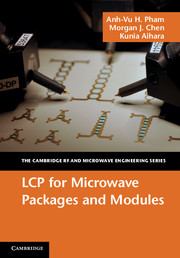Book contents
- Frontmatter
- Contents
- Preface
- 1 Introduction to electronic package engineering
- 2 Characteristics of liquid crystal polymer (LCP)
- 3 Fabrication techniques for processing LCP
- 4 LCP for wafer-level chip-scale MEMS
- 5 LCP for surface mount interconnects, packages, and modules
- 6 LCP for passive components
- 7 LCP for system design
- 8 LCP reliability
- Abbreviations, acronyms, and symbols
- Index
- References
1 - Introduction to electronic package engineering
Published online by Cambridge University Press: 05 July 2012
- Frontmatter
- Contents
- Preface
- 1 Introduction to electronic package engineering
- 2 Characteristics of liquid crystal polymer (LCP)
- 3 Fabrication techniques for processing LCP
- 4 LCP for wafer-level chip-scale MEMS
- 5 LCP for surface mount interconnects, packages, and modules
- 6 LCP for passive components
- 7 LCP for system design
- 8 LCP reliability
- Abbreviations, acronyms, and symbols
- Index
- References
Summary
Over the last few decades, major advancements in the semiconductor supply chain have occurred. These advancements have provided standard foundry processes, physical theories that explain device models, accurate and efficient software, and test equipment. Today, front-end components up to 95 GHz (E-band) and beyond are either commercially available or can be specifically commissioned. In all these advancements, packaging has been the one area where investments and technology have lagged.
In many cases, packaging presents the major bottleneck to overall performance. As trivial as the connection of components may sound, the unfortunate reality is that the signal integrity of interconnects quickly limits performance at high frequencies. Engineers in the digital world are now coming up against some of these limitations, and only recently has the field made the investments necessary for these signal integrity issues to be overcome. Even microwave engineers, whose whole world is high frequency, struggle to find acceptable packaging solutions. Many will be faced with designs riddled with crippling mismatch loss, coupling loss, and unacceptable resonances.
For many engineering projects, cost is also an important design criterion and differentiating feature. Without careful, directed analysis, engineers may find their projects behind schedule and over budget. Further, lower operating costs can be achieved with package designs that encourage simple fabrication, assembly, handling, and test. Packaging research helps to advance new design techniques and package processes. For these reasons, packaging is rapidly gaining attention as a necessary growth field.
- Type
- Chapter
- Information
- LCP for Microwave Packages and Modules , pp. 1 - 15Publisher: Cambridge University PressPrint publication year: 2012



